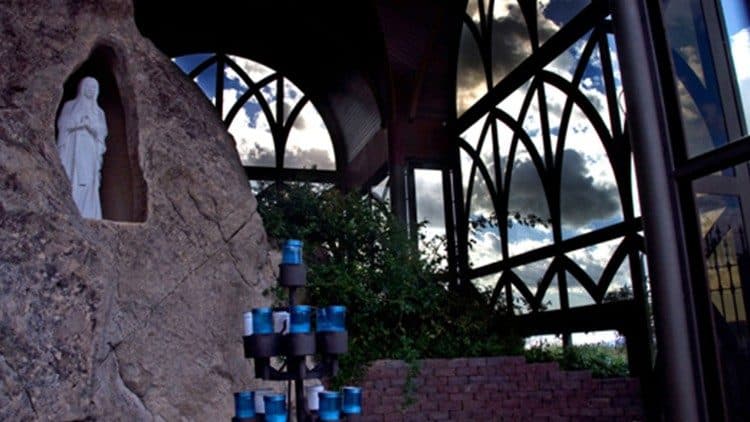ROME – Since unveiling a new set of norms for evaluating the validity of alleged Marian apparitions and other spiritual phenomena two months ago, the Vatican has put out rulings on several cases, recently approving devotion to two popular Marian appearances in Italy.
In mid-May, the Vatican’s Dicastery for the Doctrine of the Faith (DDF) published a new expedited procedure for vetting spiritual phenomena in which things such as alleged Marian apparitions will no longer be judged “supernatural,” but simply that nothing stands in the way to promoting devotion.
According to the new norms, six different “prudential conclusions” will be given, depending on the case, ranging from a Declaratio de non supernaturalitate, meaning it is false, to a Nihil obstat, meaning devotion can be promoted.
RELATED: In new vetting process for apparitions, Vatican nixes ‘supernatural’ label
Less than a month later, the Vatican issued a ruling on one of Italy’s most famed and contested alleged Marian apparitions, known as the “bleeding Madonna” in the central Italian town of Trevignano Romano, where since 2016 a woman named Gisella Cardia has claimed that a statue of Mary she bought in Medjugorje has been bleeding from the eyes, while Mary has been giving her private revelations.
On June 27, after a local diocesan investigation, the Vatican in its first implementation of the new norms on judging spiritual phenomena ruled that the Trevignano Madonna was “not supernatural,” and forbid spreading devotion.
RELATED: Vatican formally declares Italy’s ‘bleeding Madonna’ a false apparition
Around two weeks later, the DDF on July 5 issued rulings on two other alleged Marian apparitions, “Mary Mystical Rose” in Brescia, and “Our Lady of the rock” in Santa Domenica, Placanica.
In a letter addressed to Bishop Pierantonio Tremolada of Brescia, the DDF prefect, Argentine Cardinal Víctor Manuel Fernández, gave a green light to the devotion, saying in the dicastery’s inquiry, “no elements in the messages spread by Pierina Gilli that directly contradict the teaching of the Catholic Church on faith and morals” were found.
“Nor can one find any negative moral aspects or other critical aspects in matters relating to this spiritual experience. Rather, one can find several positive aspects that stand out in the messages as a whole and others that deserve clarification to avoid any misunderstanding,” he said.
The devotion to Mary Mystical Rose in Bresica began when Italian laywoman and alleged visionary Pierina Gilli, born into a poor family and who later worked as a nurse in a hospital, living a simple life, apparently had visions of Mary in 1947, visions she said happened again in 1966.
In 1947, Gilli said Mary appeared to her with the titles “Mystical Rose” and “Mother of the Church,” wearing a white dress with three roses on it – one white, one red, and one yellow, which she said symbolized prayer, penance and suffering.
Gilli said a second cycle of apparitions occurred in 1966 in Fontanelle, located south of Montichiari, in the province of Brescia, when on May 13 of that year – the day on which the famed Marian apparitions of Fatima began – Mary allegedly appeared to Gilli again, directing her to a specific spring which she said was a place of purification and a source of grace.
After that, construction began for a shrine in that location, with the structure set to be an open amphitheater, rather than a church, with a chapel on one side to celebrate Mass, and a second, smaller chapel on the other side to protect the spring indicated by Mary in the alleged apparition.
Local bishops at first were hesitant to make any rulings on the phenomenon, however, in 2001, the 10th anniversary of Gilli’s death in 1991 at the age of 80, then-Bishop Giulio Sanguineti tapped a priest to investigate, and in 2019 the shrine was officially adopted at a diocesan level.
The DDF’s ruling officializes the Brescia devotion as positive and good for the spiritual life of faithful.
On July 5 the DDF also gave a Nihil obstat to the Our Lady of the Rock spiritual occurrence in Santa Domenica di Placanica, in the southern region of Calabria, which dates to 1968, when alleged visionary Brother Cosimo Gragomeni, then an 18-year-old shepherd, allegedly had visions of Mary from May 11-14 of that year.
In a letter to Bishop Francesco Oliva of Locri-Gerace, Fernandez said that over the years, “no critical or risky elements have emerged, much less problems of obvious gravity. Instead, there are signs of grace and spiritual conversion.”
“Therefore, in consideration of what you have written, and without making any judgment on whether the events relating to the spiritual experience in question were supernatural or not, this Dicastery confirms the Nihil Obstat determination that you have proposed,” he said.
According to Gragomeni, the first apparent apparition happened in 1968 and was preceded by a beam of light coming from a sandstone rock near a young man’s home, a beam that appeared for the next four consecutive days.
Gragomeni said Mary’s message to him included an invitation to prayer and conversion, as well as a desire to see the local town transformed into a center of spirituality where people encounter God’s mercy.
In response, Gragomeni cleared the area around the rock and created a niche in the sandstone where he placed a small marble statue of Mary that he had purchased in Carrara. The town soon became a popular pilgrimage destination throughout Italy.
A larger shrine was later built at the site, and in 1987, Gragomeni became a Franciscan tertiary. In 2008, a diocesan investigation began into the phenomenon, and in 2013, Gragomeni attended a general audience with Pope Francis and asked him to bless the first stone of the shine of Our Lady of the Rock that was being built.
The shrine was adopted as a diocesan sanctuary in 2016, and the DDF’s ruling this month further encourages devotion.
Fernandez said in his letter that “in the secularized world in which we live, in which so many spend their lives without any reference to transcendence, the pilgrims who approach the Shrine of the Rock are a powerful sign of faith.”
“Their presence before the Virgin, who for them becomes a clear expression of the Lord’s mercy, is a way of acknowledging their own inadequacy to carry out the labors of life and their ardent need and desire for God,” he said, saying, “In such a truly precious context of faith, a renewed proclamation of the kerygma can continue to enlighten and enrich this experience of the spirit.”
On July 11, the DDF also published the unanimous decision, approved by Pope Paul VI in 1974, which confirmed the “non-supernaturality” of devotion to the alleged Dutch Marian apparitions in Amsterdam, dubbed “Our Lady of All Nations.”
The alleged apparitions date to March 25, 1945, when a woman named Ida Peerdeman claimed to have seen Mary, who introduced herself with the title, “Lady of All Nations.” She later claimed to have had 55 more visions of Mary, lasting until 1959, with Mary revealing events such as the death of Pope Pius XII.
Mary also apparently requested that the church recognize the dogma of Mary as “co-redemptrix,” a title Pope Francis has voiced skepticism over on several occasions.
In a press release, the DDF said that it typically “did not reveal decisions regarding alleged supernatural phenomena.”
However, it said that it had chosen to do so in this case due to “persistent doubts raised about the alleged apparitions and revelations from 1945-1959 in Amsterdam, related to the devotion of the ‘Lady of All Nations.’”
Dated March 27, 1974, the ruling found that the apparitions were not supernatural and blocked further investigation into the phenomena. While the decision had been privately communicated to the local bishop, the DDF said it published the decree now to avoid any confusion.
Follow Elise Ann Allen on X: @eliseannallen













